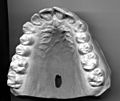Dental formula facts for kids
A dental formula is like a special code that tells us about the teeth of a mammal. It's a quick way to show how many of each type of tooth an animal has.
Almost all mammals have four main kinds of teeth:
- incisors: These are the flat, sharp teeth at the front, used for biting and cutting food.
- canines: These are the pointy teeth, often used for gripping or tearing food.
- premolars: These teeth are behind the canines and have a flatter surface, good for crushing and grinding.
- molars: These are the largest teeth at the back of the mouth, perfect for serious grinding of food.
Animals have different teeth because they eat different things. Over time, mammals have changed their teeth to fit their diet. This means the number and shape of their teeth have adapted to what they eat.
Contents
Understanding a Dental Formula
A dental formula shows the number of teeth for just one side of an animal's mouth. It lists the upper teeth and lower teeth on separate rows. To find the total number of teeth in the animal's mouth, you simply double the numbers in the formula.
Reading the Code
In a dental formula, the teeth are always listed in a specific order:
- I for incisors
- C for canines
- P for premolars
- M for molars
So, the order is always I:C:P:M. For example, if you see 2.1.2.3 for upper teeth, it means there are 2 incisors, 1 canine, 2 premolars, and 3 molars on one side of the upper jaw.
Baby Teeth vs. Adult Teeth
Just like humans, many mammals have two sets of teeth during their lives. They have "baby teeth" (also called deciduous teeth) first, which later fall out and are replaced by "adult teeth" (permanent teeth).
When writing a formula for baby teeth, a lowercase letter 'd' is added before the tooth type, like di:dc:dm. A full dental formula often looks like a fraction, showing upper teeth over lower teeth: I.C.P.M / I.C.P.M.
Examples of Dental Formulas
Since the teeth are always listed in the same order, the letters (I, C, P, M) are often left out.
Human Teeth
- Baby teeth: 212/212
- Adult teeth: 2123/2123
This means that on one side of a human's mouth, adults have 2 incisors, 1 canine, 2 premolars, and 3 molars on both the top and bottom. The two baby molars are replaced by adult premolars. If you double the adult formula (2+1+2+3 = 8 teeth per side, top and bottom), you get a total of 32 adult teeth.
Opossum Teeth
- Formula: 5134/4134
Opossums have a lot of teeth! Notice they have one less incisor on each side of their lower jaw compared to their upper jaw.
Cat Teeth (Felines)
- Formula: 3131/3121
Cats have special teeth called 'carnassials'. These are like sharp scissors used for slicing meat and skin. The carnassial teeth are always the fourth upper premolar and the first lower molar.
Horse Teeth
- Formula: 313-43/3133
Horses have teeth that are perfectly suited for eating grass. Their teeth grow continuously from the roots to make up for the wear and tear from grinding tough grass. Horse teeth fall into two clear groups: their incisors grab the grass, and their molars grind it up.
The Diastema
Both cats and horses have a large gap between their front teeth and their back teeth. This gap is called a diastema. It's a natural feature found in many different types of mammals.
Images for kids


